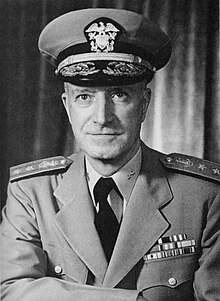William Sterling Parsons
Rear Admiral William Sterling "Deak" Parsons (born November 26, 1901 in Chicago , † December 5, 1953 in Bethesda [Maryland] ) was an American naval officer who worked as an ordnance expert for the Manhattan Project during World War II . He is best known as a weapons system officer for the Enola Gay , where he did not make the atomic bomb Little Boy ready to be released until it was launched. Parsons had observed several B-29s in take-off accidents on the island of Tinian . In order to rule out the possibility of a nuclear explosion on Tinian, he decided to arm the weapon only in flight. This was not previously discussed with Leslie Groves , the military director of development of the first atomic bomb in the so-called Manhattan Project. Parsons received the Silver Star for his role in the Mission .
Life
Parsons graduated from the United States Naval Academy in 1922 and served on various warships, beginning with the New Mexico-class battleship USS Idaho . He studied ballistics at the Naval Proving Ground in Dahlgren, Virginia. In July 1933, Parsons became the liaison officer between the Bureau of Ordnance and the Naval Research Laboratory. He became interested in radio measurement methods early on and was one of the first to recognize their potential. In September 1940 Parsons worked on the development of a proximity fuse for anti-aircraft grenades, which eventually became known as the VT Fuse Mk. 32. This went into production in 1942. Parsons was present as the cruiser USS Helena shot down the first enemy aircraft with a VT fuze shell during the Battle of Guadalcanal in January 1943 . This top secret detonator significantly increased the losses of Japanese fighter pilots.
In 1943, Leslie Groves , head of the Manhattan Project , was urgently looking for a specialist to detonate the atomic bombs that were still in development. Eventually Parsons was recommended to him. In June 1943, Parsons joined as an Associate Director in the Research Laboratory of Los Alamos (New Mexico) under Robert Oppenheimer in the Manhattan project. Parsons was responsible for the development of the bombs and the radar level fuse, including the design and testing of the non-nuclear components of nuclear weapons ( Project Alberta ). After it became clear that the simple but very reliable " cannon principle " would not work with the "Thin Man" plutonium bomb , Parsons was only responsible for the Little Boy uranium bomb. Another team was founded under Seth Neddermeyer and later George Kistiakowsky for the construction of the plutonium implosion bomb . However, Parsons was on board a B-29 as an observer when the Trinity test was carried out. Immediately afterwards he traveled to Tinian, where he awaited the arrival of the atomic bomb.
After the war, Parsons was promoted to rear admiral without ever having commanded a ship. In 1946 he was involved in Operation Crossroads , the nuclear weapons tests in Bikini Atoll, and later in Operation Sandstone , the tests in Eniwetok Atoll in 1948. In 1947 he became deputy commander of the special weapons project. He died of a heart attack on December 5, 1953. He left behind his wife and two daughters.
literature
- Albert B.Christman: Target Hiroshima (Deak Parsons and the Creation of the Atomic Bomb), 1998, Naval Institute Press Annapolis ISBN 1-55750-120-3
- Leslie Groves: Now it Can be Told (The Story of the Manhattan Project), 1962, Harper & Row-New York, ISBN 0-306-70738-1
| personal data | |
|---|---|
| SURNAME | Parsons, William Sterling |
| ALTERNATIVE NAMES | Parsons, Deak (nickname) |
| BRIEF DESCRIPTION | American naval officer |
| DATE OF BIRTH | November 26, 1901 |
| PLACE OF BIRTH | Chicago |
| DATE OF DEATH | 5th December 1953 |
| Place of death | Bethesda, Maryland |

